Are you interested in discovering how 1974 pennies made from aluminum instead of copper are worth an estimated $2 million? Yes, you heard right — two million dollars. If you’re curious about the truth, keep reading.
In this guide, we’ll evaluate and grade 1974 Lincoln cents and explain why owning a 1974 Aluminum penny is considered illegal. Besides uncovering the story behind these rare coins, you’ll also learn how to appraise a coin by examining its grade, mint mark, and potential errors.
1974 Penny Details
- Category: Lincoln Penny
- Year: 1974
- Mint Locations: Philadelphia, San Francisco, and Denver
- Total Mintage: 8,876,665,183
- Obverse Designer: Victor D. Brenner
- Reverse Designer: Frank Gasparro
- Coin Shape: Round
- Edge: Plain
- Diameter: 19 mm
- Composition: 95% Copper, 5% Zinc
- Weight: 3.11 g
Finding a regular 1974 penny is easy, as their face value and actual value are nearly the same. However, a few unique and rare pieces exist that can fetch a small fortune.
In this article, we’ll break down everything about the coin’s design, materials, and special features that make some 1974 pennies extremely valuable — especially the illegal-to-own aluminum versions.
1974 Penny History

The year is 1973, and the cost of producing copper coins was rising. In fact, the cost of making one cent from copper was equal to the coin’s face value, prompting the need for change.
To address this, the United States Mint chose alternative metals: aluminum and bronze-clad steel were selected due to their durability and resistance to tarnish.
Approximately 1,571,167 Aluminum 1974 Lincoln cents were produced, and samples were distributed to Congressmen to gain support for the new pennies. However, production was halted before public release due to several issues:
- Mechanical problems with vending machines caused by the new aluminum coins.
- Vending machine manufacturers refused to modify machines to accept aluminum pennies.
- Safety concerns: if children swallowed aluminum pennies, detecting them via X-ray would be difficult.
As a result, the Mint decided to recall the distributed aluminum pennies, but several samples remain unrecovered. When asked, many Congressmen claimed they never received any samples.
Today, 1974 Aluminum Lincoln pennies in circulation are illegal and considered government property. When found, the Secret Service seizes them. One coin was donated to the Smithsonian Institution.
Notable events involving the 1974 Aluminum penny include:
- February 20, 2001: Officer Albert Toven of the US Capitol Police possessed a specimen, originally thought to be a dime dropped by an unnamed Congressman. The Congressman allowed Officer Toven to keep it. This coin is certified by the Professional Coin Grading Service.
- January 2014: A 1974-D aluminum cent found by Randy Lawrence (whose father was a former Deputy Superintendent of the US Mint) was valued between $250,000 and $2 million and graded MS63 by the Professional Coin Grading Service. Randy planned to auction the coin to fund travel and charity, but the US Mint requested its withdrawal from the auction. After legal disputes, the US Mint now holds the coin in the United States Bullion Depository.
Regarding bronze-clad steel pennies, fewer details are known. Some were supposed to be destroyed but escaped melting. The first known specimen surfaced in 1994. The owner, a Pennsylvania steel mill worker in 1974, recalled that mint officials brought coins for destruction, but a bag broke open, and some coins were lost and never recovered.
The Obverse
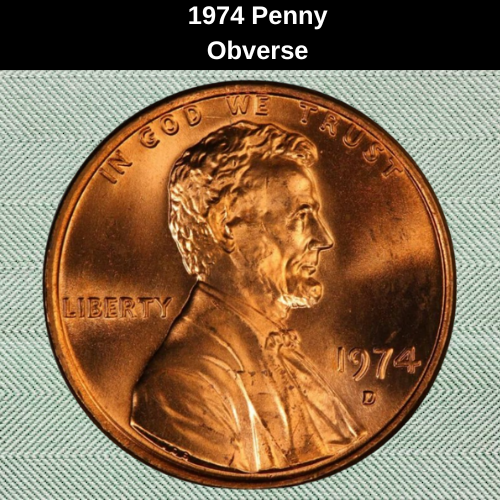
On the obverse of the 1974 Lincoln penny, you’ll notice several key features:
- A right-facing portrait of Abraham Lincoln, the 16th President of the United States.
- The mint mark, located just below the year “1974”, which identifies the U.S. Mint facility where the coin was struck (Philadelphia, Denver, or San Francisco).
- The national motto “In God We Trust”, arched above Lincoln’s head.
- The word “Liberty”, positioned to the left of the portrait.
These elements have remained largely consistent on Lincoln pennies since their introduction in 1909.
The Reverse
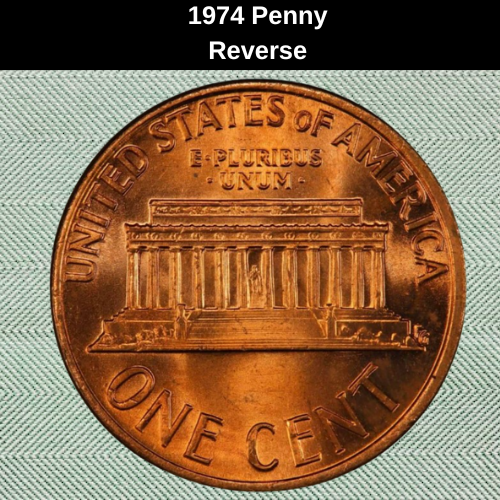
The reverse of the 1974 Lincoln penny showcases the Lincoln Memorial, centered prominently on the coin. Designed by Frank Gasparro, this reverse replaced the original wheat ears design in 1959 to commemorate Lincoln’s 150th birthday.
Key inscriptions on the reverse include:
- “UNITED STATES OF AMERICA”, along the top edge
- “E PLURIBUS UNUM”, above the Memorial
- The coin’s denomination, “ONE CENT”, along the bottom rim
Gasparro’s initials, “FG”, can also be found near the base of the Memorial, typically to the right of the steps.
1974 Penny Value Chart by Mint Mark and Condition
| Mint Mark | Choice Uncirculated (MS 63) | Gem Uncirculated (MS 65) | Superb Gem Uncirculated (MS 67) |
|---|---|---|---|
| 1974 (No Mint Mark – Philadelphia) | $7 | $18 | $120 |
| 1974 “D” (Denver Mint) | $5 | $15 | $135 |
| 1974 “S” (San Francisco Mint) | $7 | $20 | $550 |
1974 Penny Grading
The value of a 1974 Lincoln penny depends heavily on its grade, which is determined using the Sheldon Scale. While most of these coins found in circulation have little added value, those in the highest grades—Gem Uncirculated (MS65), Superb Gem Uncirculated (MS67), and Proof (PR)—are significantly more valuable due to their condition.
- Gem Uncirculated and Superb Gem Uncirculated coins display strong luster, a shiny surface, and minimal contact marks.
- Proof coins are specially minted and usually have mirror-like finishes and virtually no imperfections.
Grading Scale Overview
| # | Grade |
|---|---|
| 1 | Basal State-1 |
| 2 | Fair |
| 3 | Very Fair |
| 4–6 | Good |
| 7–10 | Very Good |
| 12–15 | Fine |
| 20–30 | Very Fine |
| 40 | Extremely Fine |
| 50 | About Uncirculated |
| 60 | Mint State (MS60) |
| 65 | Gem Mint State (MS65) |
| 70 | Perfect Mint State (MS70) |
Tip: Be sure to consult a coin grading guide or a professional appraiser to properly assess your coin’s value. Grading is the essential first step to determine if your 1974 penny is a common piece—or a rare treasure.
1974 Penny Values and Varieties Guides
1974 No Mint Mark Penny Value

- Mint Location: Philadelphia
- Mint Mark: None
- Obverse Designer: Victor David Brenner
- Reverse Designer: Frank Gasparro
- Face Value: One Cent
- Dollar Value: Varies by grade
- Number of Coins Minted: 4,232,140,523
The 1974 Philadelphia-minted Lincoln pennies were struck in massive quantities. As with most high-mintage coins, a regular 1974 Lincoln penny from the Philadelphia Mint typically holds little premium—only slightly above face value in circulated condition.
However, there are exceptions:
- A superb Gem uncirculated 1974 Philadelphia penny can reach up to $115.
- A record-breaking auction sale in 2013 saw one of these coins sell for $2,938, making it a standout among otherwise common examples.
1974 D Mint Mark Penny Value
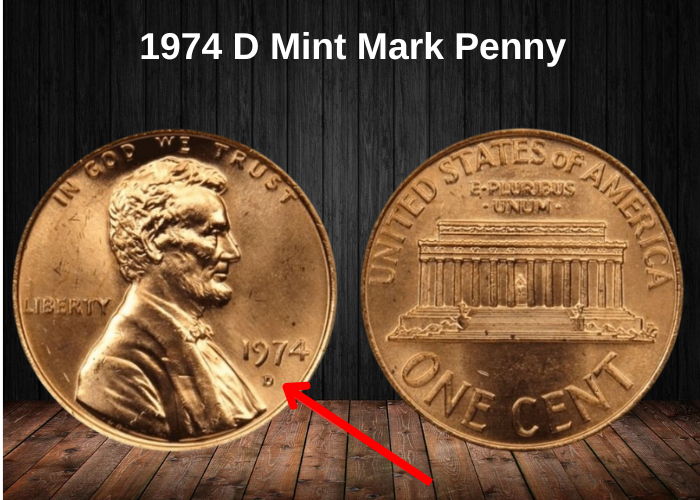
- Mint Location: Denver
- Mint Mark: “D”
- Obverse Designer: Victor David Brenner
- Reverse Designer: Frank Gasparro
- Face Value: One Cent
- Dollar Value: Varies by grade
- Number of Coins Minted: 4,235,098,000
The Denver Mint produced more than four billion Lincoln pennies in 1974, making most of them common and generally worth face value in circulated condition.
However, high-grade specimens hold notable value:
- A superb Gem uncirculated example can fetch up to $650.
- The record price for a Denver mint 1974 penny is $950, paid for a VF25RD graded coin sold on eBay on January 17, 2019.
1974 S Mint Mark Penny Value
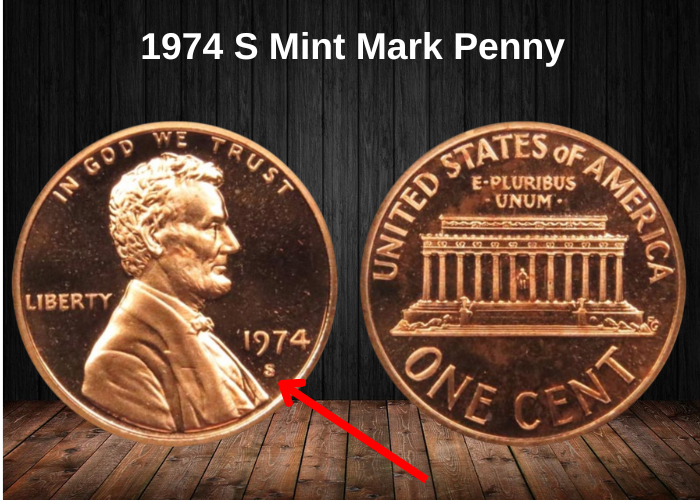
- Mint Location: San Francisco
- Mint Mark: “S”
- Obverse Designer: Victor David Brenner
- Reverse Designer: Frank Gasparro
- Face Value: One Cent
- Dollar Value: Varies by condition
- Number of Coins Minted: 412,039,228
The San Francisco Mint struck the fewest 1974 Lincoln pennies, with a mintage of just over 412 million. While most are modest in value, superb Gem uncirculated examples can be worth at least $550.
The highest recorded sale of a 1974-S penny was for a coin graded MS67RD by Heritage Auctions in 2016, which sold for an impressive $2,703.
1974 No Mint Mark Aluminum Penny Value

- Mint Location: Philadelphia
- Mint Mark: None (also known examples with “D”)
- Obverse Designer: Victor David Brenner
- Reverse Designer: Frank Gasparro
- Face Value: One Cent
- Dollar Value: Estimated $160,000 – $2,000,000
- Number of Coins Minted: Unknown
- Weight: 0.93g
Owning a 1974 Lincoln Penny made from aluminum is illegal, as most specimens were recalled, destroyed, or donated to institutions.
The only certified 1974 aluminum penny in private hands has no mint mark and is worth an estimated $160,000. However, if another were to surface today in uncirculated condition, it could be valued at up to $2 million.
1974 D Mint Mark Aluminum Penny Value
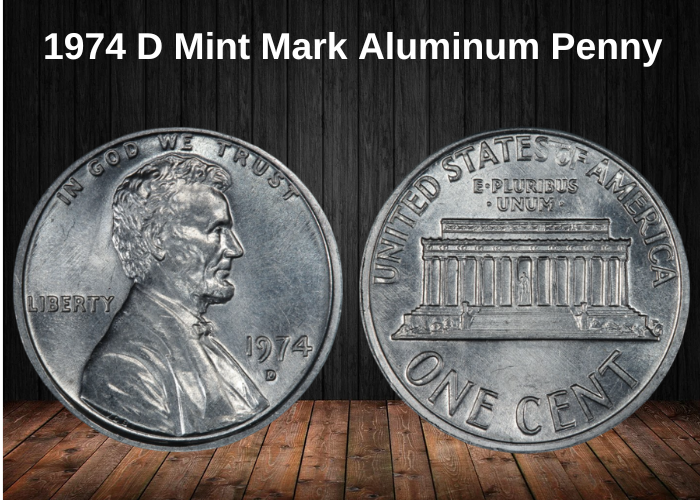
- Mint Location: Philadelphia and Denver
- Mint Mark: None, D
- Obverse Designer: Victor David Brenner
- Reverse Designer: Frank Gasparro
- Face Value: One Cent
- Dollar Value: Estimated $250,000
- Number of Coins Minted: Unknown
- Weight: 0.93g
The Denver Mint is believed to be responsible for producing a few 1974 aluminum pennies that are still in private hands today.
One of these rare coins made headlines in 2013, drawing attention from the numismatic community and eventually the U.S. Secret Service. The U.S. Government litigated ownership of the coin due to its status as an unauthorized issue.
Before legal action, this verified coin was valued at $250,000.
Rare 1974 Penny Error List
1974 Lincoln Penny Double Die Errors
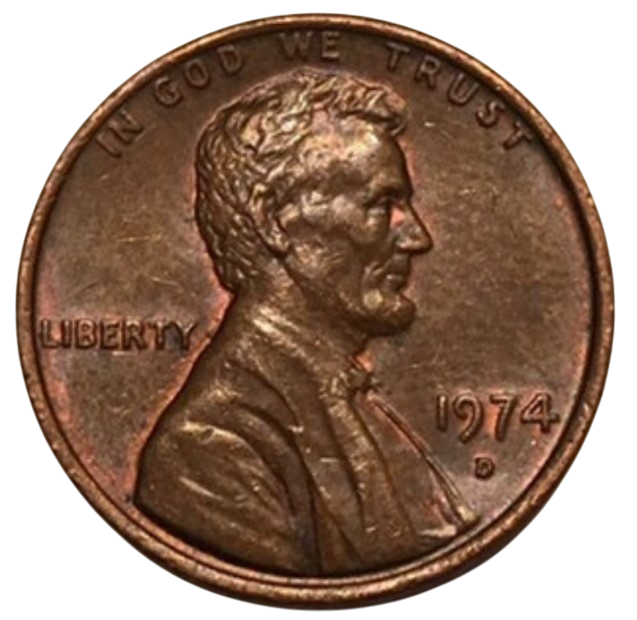
Double die errors create a doubling effect on certain features of the 1974 Lincoln Penny. On the obverse of coins from the Denver Mint, this doubling can be seen on the “D” mint mark, Lincoln’s nose, the year of production, and the legends. On the reverse, the doubling appears on the pillars and stairs of the Lincoln Memorial image.
These double-die errors are generally valued at around $25, though the exact value depends on the coin’s grade.
1974 Lincoln Penny Double Head Errors
The double head error happened because the coins were counter-stamped after minting, resulting in two Lincoln heads appearing on the coin’s obverse. Although this error is highly sought after, it has little to no numismatic value.
1974 “S” Penny with a Die Break Error
There is a 1974 penny with an S mint mark that shows a visible die break error on its obverse. While this error often happens from damage during circulation, sometimes it’s due to a Mint defect. In these cases, you might notice a missing piece on the obverse or reverse of the coin. Because this error is rare, a specimen in pristine condition can be valued up to $184.
Where to sell your penny?
Now that you know the value of your penny, you might be wondering where to sell it. Don’t worry: here’s a guide to some of the best online platforms where you can easily sell your coins, along with their advantages and disadvantages.
Discover the best platforms for selling coins online (pros and cons).
1974 Lincoln Penny FAQs
1. What is the typical value of a 1974 Lincoln penny?
Most 1974 Lincoln pennies in circulated condition are worth their face value (1 cent). However, uncirculated specimens, especially those graded MS60 and above, can be worth between 50 cents and $3 depending on the mint mark and overall condition.
2. Were there any major varieties or errors in the 1974 penny?
The 1974 penny is not known for dramatic error varieties like the famous 1972 DDO. However, there are some minor varieties and errors collectors look for:
- Repunched Mint Marks (RPMs) on Denver (D) and Philadelphia (no mint mark) coins
- Minor die cracks
- Double dies with very subtle doubling that usually require magnification
- Off-center strikes or planchet flaws, though these are less common
3. What was the mintage of the 1974 penny, and how does it impact rarity?
The 1974 Lincoln pennies were minted in very large quantities:
- Philadelphia (no mint mark): over 4.3 billion
- Denver (D mint mark): over 2.8 billion
- San Francisco (S mint mark, proof only): about 11 million
This high production makes 1974 pennies very common, and not considered rare in any condition.
4. What’s the difference between circulation strikes and proof pennies for 1974?
- Circulation strikes were produced for general circulation and typically show some wear.
- Proof coins (1974-S) were minted specifically for collectors, with a sharper design, higher relief, and mirror-like finish.
Proof pennies in high grades (e.g., PR67 or higher) can be worth $10 to $25, especially in Deep Cameo condition.
5. Are there any notable errors or varieties that increase the 1974 penny’s value?
While the 1974 penny has no major famous doubled die varieties, errors such as:
- Die cracks
- Off-center strikes
- Repunched mint marks (RPM)
- Planchet defects
can add value, typically ranging from $10 to $100 depending on rarity and condition.
6. How does the 1974 penny fit within the Lincoln Memorial series?
The 1974 penny is part of the Lincoln Memorial design series minted from 1959 to 2008. It represents the stable era before the composition change in 1982 and is a common date often collected as part of complete sets.
7. How can collectors identify and authenticate 1974 pennies?
Collectors should check:
- The mint mark (or absence) on the obverse under the date
- Overall surface condition and luster
- Look carefully for any errors or doubling under magnification
- Weigh the coin to confirm clad composition (post-1982 pennies have a different weight)
For rare or valuable varieties, professional grading and authentication by PCGS or NGC is recommended.


















































